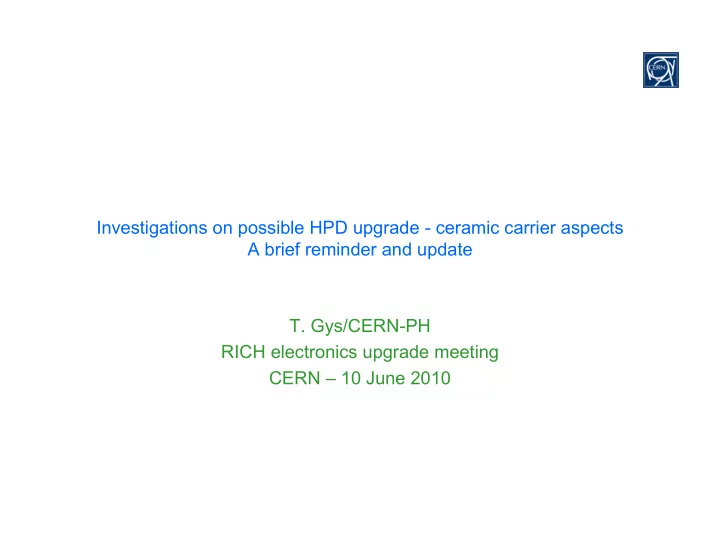

Investigations on possible HPD upgrade - ceramic carrier aspects A brief reminder and update T. Gys/CERN-PH RICH electronics upgrade meeting CERN – 10 June 2010
Introduction • What will be dealt with today: – basic ceramic carrier aspects for “new HPD option 2” – related speed requirements aspects – related HPD manufacturing aspects • What will not be dealt with today: – overall HPD vacuum aspects – possible overall HPD design aspects – overall project aspects • The following slides are the result of detailed on-going discussions with Kyocera in liaison with Milano people (G. Pessina and C. Gotti) RICH upgrade electronics – T. Gys – 10.6.2010 Slide 2
New HPD option 2: sketch - reminder HPD part HPD tube Vacuum-compatible body Pin-through electro-plating Detector chip Vacuum PGA ZIF Socket LGA/BGA standard package or custom External part In Out high-density PCB No vacuum HPD compatibility ASIC chips required mechanical baseplate Printed circuit board RICH upgrade electronics – T. Gys – 10.6.2010 Slide 3
New HPD option 2 - reminder • Anode design – Pixel detector (only) encapsulated inside vacuum and directly bump-bonded to ceramic carrier (cf. 61- and 163-pixel HPDs) – Readout ASIC(s) external • “Speed” requirements: – Analogue data typ. <5000e- charge pulse – Maximize SNR and minimize cross-talk • Notes/comments/concerns: – Vacuum compatibility: • Bake-out cycle (300°C) ⇒ high T bump-bonding (?) • Outgassing properties after tube sealing – No heat dissipation (transfer) issue from the vacuum to the external world RICH upgrade electronics – T. Gys – 10.6.2010 Slide 4
New HPD option 2 (2) – reminder + note • Notes/comments/concerns (2): – Speed limitations: • Capacitive load to FE electronics • Cross-talk • PGA carrier: – capacitive load increased by plating pattern (standard electro-plating cf 61-pixel carriers), can be minimized without plating pattern (pin-through electro-plating) – min. 1.27mm pin pitch (interstitial socket) – NOTE: previous carriers (61- and 163-pixels) were not optimized electrically: no guards, no ground planes, additional plating pattern, pin pattern not matching pixel pattern; maximum capacitive load 3.6pF for the 61-pixel carrier and between 3.5 and 6.2pF for the 163-pixel carrier • ZIF socket/PCB/ASIC package and/or interface speed limitations – related ASIC FE developments – ZIF socket results in minimized mechanical stresses RICH upgrade electronics – T. Gys – 10.6.2010 Slide 5
New HPD option 2 (3) - reminder • Notes/comments/concerns (3): – Detector “packaging” in carrier: • “Relaxed” bump-bonding process: typ. 400um bump size and 800um bump pitch and compatibility with bake-out (300°C) • Au-plating quality and compatibility with bake-out (300°C) ⇒ electro-plating – Kovar ring interface and related mechanical, brazing (850°C) and welding aspects RICH upgrade electronics – T. Gys – 10.6.2010 Slide 6
Tentative pixel sensor: sketch - reminder • Overall sensor 18mm active diameter • Pixel: – number: 490 ( ≤ 512) – size: 0.8mm flat-to-flat – capacitance «0.5pF • Carrier output pins as close as possible to pixels • Carrier overall size 50mm sq. (similar to current carrier) RICH upgrade electronics – T. Gys – 10.6.2010 Slide 7
Current status • Preliminary carrier design from Kyocera, based on 490-pixel sensor – made available on 31.10.2009 – additional info on capacitive load provided on 16.11.2009 – no feed-back to Kyocera until March 2010 – LHCb-RICH operations and HPD performance during LHC re-start took highest (and only) priority • Basic features – 490 pixel lines designed as transmission lines with guard and embedded within ground/power planes – 529 PGA (pixel lines + power and ground connections) with 15 layers – Design based on Z0=50 Ohms as a starting point – Characteristic impedance and capacitive load: • Z0=50.4 Ohms • C0=2.3pF/cm • longest line 1.73cm – Cmax 3.98pF • shortest line 0.19cm – Cmin 0.43pF • lead-to-lead (signal-to-signal) capacitance Cm 0.02pF/cm RICH upgrade electronics – T. Gys – 10.6.2010 Slide 8
Current status (2) • Preliminary S/N ratio estimate – FE candidate: the key point (see presentation of C. Gotti dated 12.4.2010) • charge-sensitive preamplifier in 90nm CMOS – expected back in August 2010 • tailored for diamond detector – 10ke- signal and C detector 1-5pF • similar requirements for HPD with external readout • expected performance – can “t” be even larger? RICH upgrade electronics – T. Gys – 10.6.2010 Slide 9
Current status (3) and next plans • On-going carrier design optimization – Design relaxed on Z0>50 Ohms -> increased layer thickness – Suppress guards – yes or no? – Characteristic impedance and capacitive load: • Z0=65.5 Ohms • C0=1.6pF/cm • longest line 1.73cm – Cmax 2.77pF • shortest line 0.19cm – Cmin 0.30pF • lead-to-lead (signal-to-signal) capacitance Cm 0.18pF/cm • Prototyping – Kyocera “cheap” test structures: not possible – Complete carrier prototype: expensive tooling charges – Use existing carriers (not optimized electrically) 61- or 163-pixel HPDs? • Further FE design investigations • Investigations on sensor packaging aspects (e.g. bump-bonding with solder-jet technology) RICH upgrade electronics – T. Gys – 10.6.2010 Slide 10
Recommend
More recommend